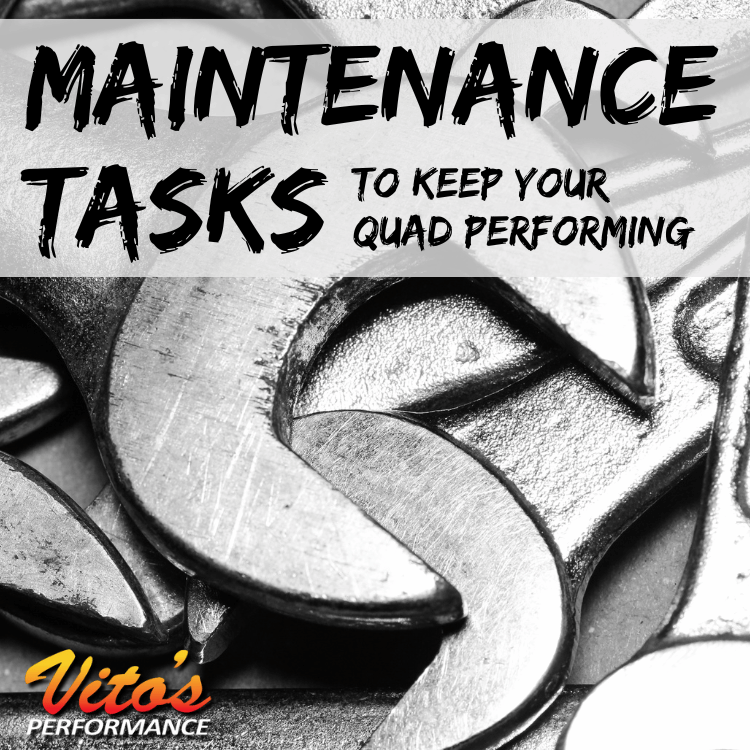Knowing how to perform basic maintenance on your ATV is essential for keeping your ride in top condition and maximizing its performance.
Whether you're riding a Yamaha Banshee, Blaster, or Raptor, understanding the mechanics behind essential repairs — such as oil changes, brake pad replacements, and carburetor adjustments — ensures your quad runs smoothly and reliably.
Not only does regular maintenance prevent costly repairs down the road, but it also helps maintain optimal performance, improves safety, and extends the life of your ATV.
Here are 10 DIY maintenance tasks and the tools you need to keep your quad performing at its best, no matter where your off-road adventures take you.
1. Oil Changes
Regular oil changes are essential for maintaining engine health. Over time, oil breaks down and loses its effectiveness, leading to increased engine wear.
Tools Needed:
- Oil Drain Pan
- Wrench Set
- Oil Filter Wrench
- Funnel
- New Oil and Oil Filter (Make sure to choose the correct type based on your model, e.g., Yamaha Banshee-specific oil filter)
-
Oil Drain Plug Gasket
How-To:
- Warm up the engine to make the oil flow more easily.
- Position an oil drain pan beneath the oil drain plug.
- Use a wrench to remove the drain plug and let the oil drain completely.
- Replace the oil filter with a new one using an oil filter wrench.
- Reinstall the drain plug and fill the engine with fresh oil, checking the oil level with the dipstick.
- Start the engine to circulate the oil, then recheck the level.
2. Replacing the Air Filter
A clean air filter is essential for optimal engine performance. Dirty or clogged filters can reduce power and efficiency.
Tools Needed:
- Screwdriver Set
- Wrench Set
- Replacement Air Filter
How-To:
- Locate the air filter compartment (usually behind the seat or on the side).
- Remove the screws or fasteners holding the cover in place.
- Pull out the old air filter and inspect it for damage or excessive dirt.
- Insert the new air filter, making sure it fits snugly.
- Reassemble the cover and fasten the screws back into place.
3. Adjusting the Carburetor
The carburetor regulates the fuel and air mixture for your engine. Over time, it may need adjustment to maintain proper engine performance.
Tools Needed:
- Screwdrivers
- Carburetor Cleaner
- Wrench Set
How-To:
- Remove the carburetor from the ATV, carefully disconnecting any fuel lines.
- Locate the idle screw and the air-fuel mixture screw.
- Adjust the idle screw to increase or decrease engine RPM.
- Adjust the air-fuel mixture screw for optimal fuel delivery—start by turning it clockwise to lean it out, or counterclockwise to enrich it.
- Reinstall the carburetor, reattach fuel lines, and test ride for performance
4. Changing the Spark Plug
Spark plugs wear out over time and need replacing. A faulty spark plug can cause poor starting, misfires, or reduced performance.
Tools Needed:
- Spark Plug Wrench
- Socket Set
- Replacement Spark Plug
How-To:
- Remove the seat and side covers to access the spark plug.
- Use a spark plug wrench to remove the old spark plug.
- Inspect the spark plug for wear or carbon buildup.
- Install the new spark plug by hand, ensuring it's snug but not too tight.
- Reattach any covers or seat components.
5. Brake Pad Replacement
Worn brake pads can significantly reduce braking efficiency. Regularly replacing the brake pads helps keep your quad safe to ride.
Tools Needed:
- Brake Caliper Tool
- Socket Wrench Set
- Replacement Brake Pads
How-To:
- Lift the ATV to access the brake system.
- Remove the wheel to expose the brake caliper.
- Use a socket wrench to remove the bolts securing the caliper.
- Slide out the old brake pads.
- Insert the new brake pads, ensuring they fit securely.
- Reattach the brake caliper and wheel and test the brakes.
6. Replacing the Chain and Sprockets
A worn-out chain and sprockets can result in poor performance and even chain failure. Replacing them regularly is a good habit.
Tools Needed:
How-To:
- Use a chain breaker tool to remove the old chain.
- Remove the rear axle and sprocket bolts to take off the worn sprockets.
- Install the new sprockets, ensuring they align correctly.
- Use the chain breaker tool to adjust the length of the new chain if necessary.
- Install the new chain and make sure it has the correct tension.
7. Changing the Transmission Fluid
Keeping your transmission fluid clean is essential for smooth shifting and to avoid costly repairs down the line.
Tools Needed:
- Drain Pan
- Wrench Set
- Funnel
- New Transmission Fluid
How-To:
- Locate the transmission drain plug and place a drain pan underneath.
- Use a wrench to remove the drain plug and let the fluid fully drain.
- Replace the drain plug and use a funnel to add fresh transmission fluid.
- Check the fluid level, ensuring it’s filled to the recommended level.
8. Suspension Maintenance
Over time, shocks and suspension components wear out. Regular maintenance will keep your ride smooth and prevent wear on other parts of your ATV.
Tools Needed:
- Suspension Wrenches
- Grease Gun
- Replacement Shocks or Bushings
- Vito's Suspension Kit
How-To:
- Lift the ATV and secure it on a stand.
- Inspect the suspension for any leaks, cracks, or excessive wear.
- If necessary, remove the old shocks by unbolting them from the frame.
- Replace with new shocks or suspension components.
- Re-grease any moving parts and check the suspension for proper function.
9. Wheel and Tire Maintenance
Ensure your tires are in good condition. Flat tires or damaged wheels can seriously affect your quad's performance.
- Tools Needed:
- Tire Repair Kit
- Tire Iron
- Wrench Set
How-To:
- Lift the ATV and remove the wheel using a wrench.
- Inspect the tire for wear, punctures, or damage.
- If repairing, use a tire repair kit to patch any holes or replace the valve stem if needed.
- If replacing, mount the new tire onto the wheel.
- Reinstall the wheel, ensuring it's properly tightened.
10. Replacing the Steering Stem
If you notice your handlebars are loose or steering feels off, the steering stem may need replacement.
Tools Needed:
- Steering Stem Wrench
- Socket Wrench Set
- Replacement Steering Stem
How-To:
- Remove the front wheels and disconnect the handlebars.
- Use a wrench to remove the bolts securing the steering stem.
- Carefully remove the old stem and insert the new one, aligning it with the steering components.
- Reassemble the handlebars and tighten the bolts securely.
- Test the steering for smooth operation.
Each repair requires the right tools and attention to detail, but with these basic steps, you can handle many common ATV maintenance tasks yourself, keeping your ride running smoothly for years to come.




